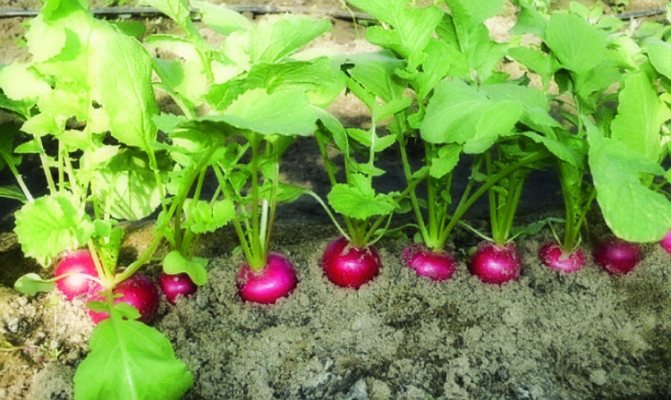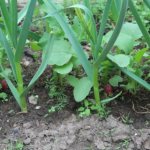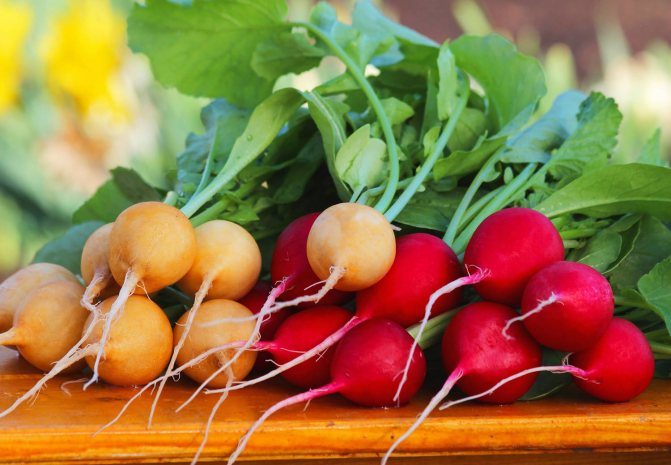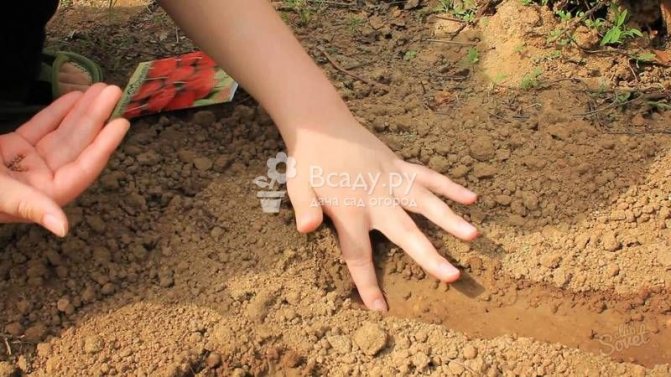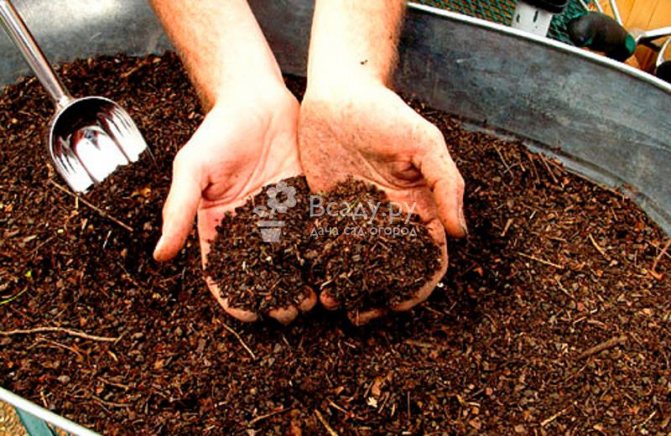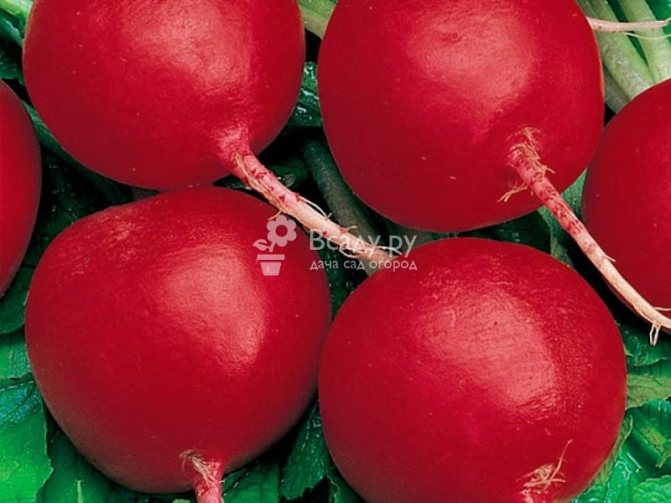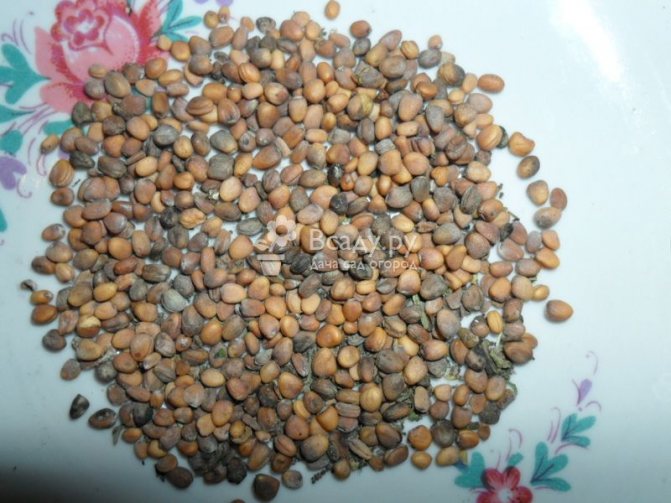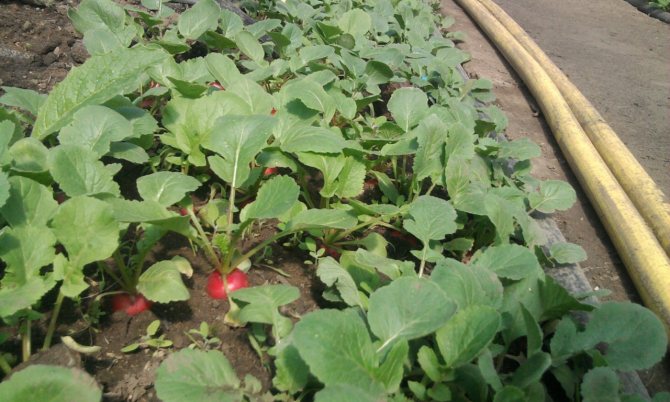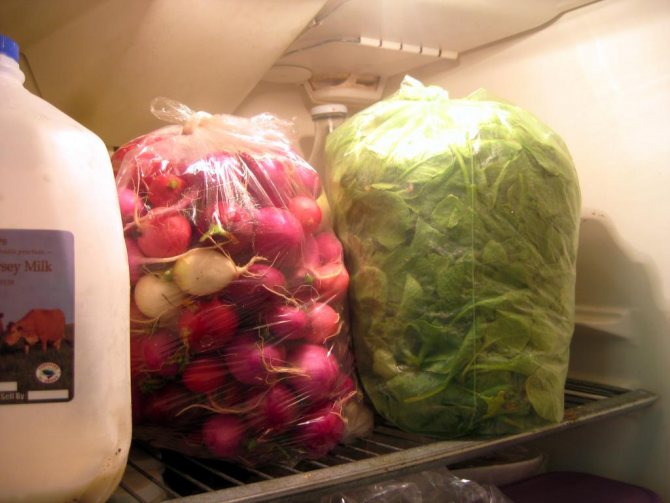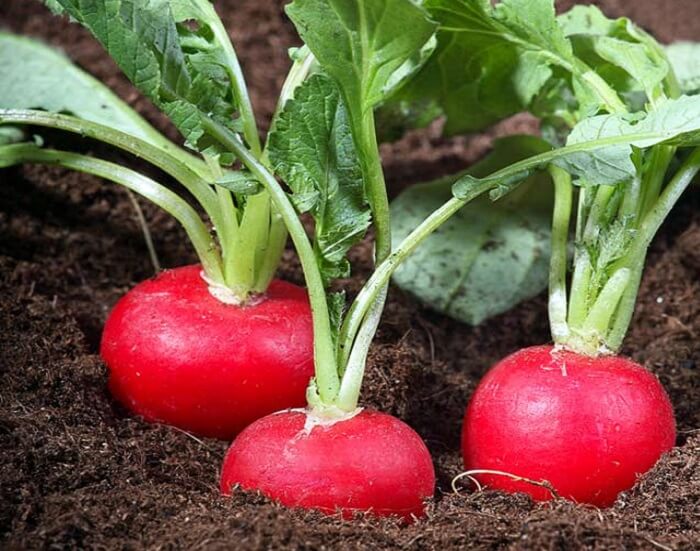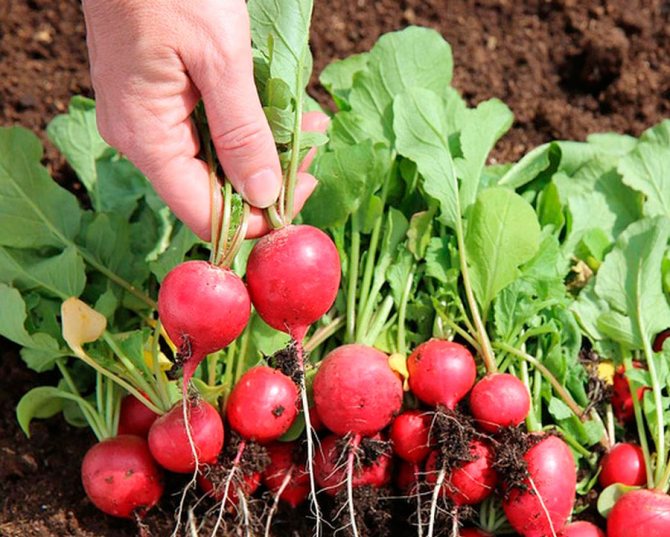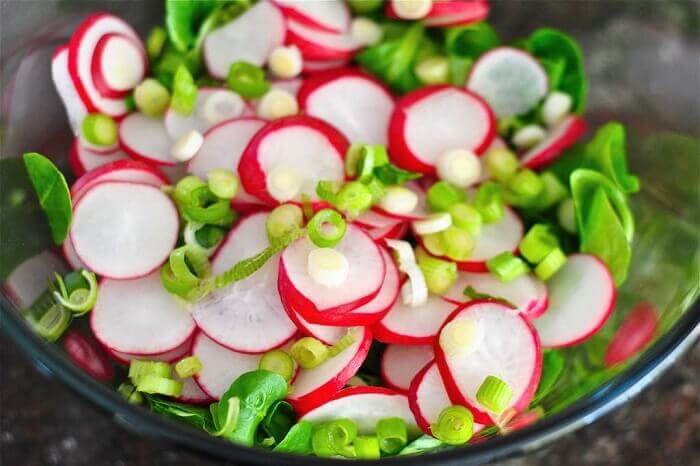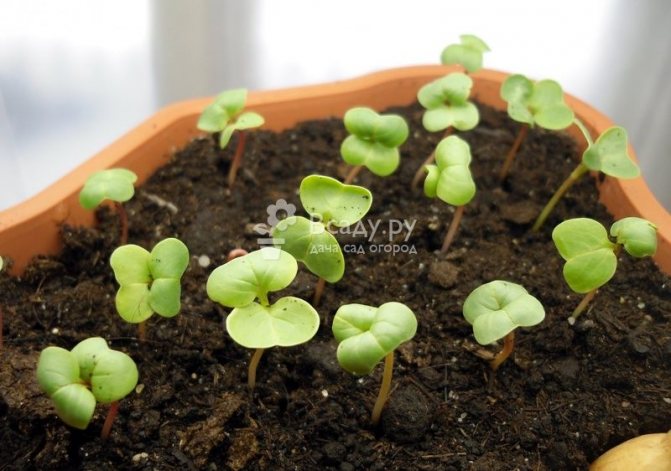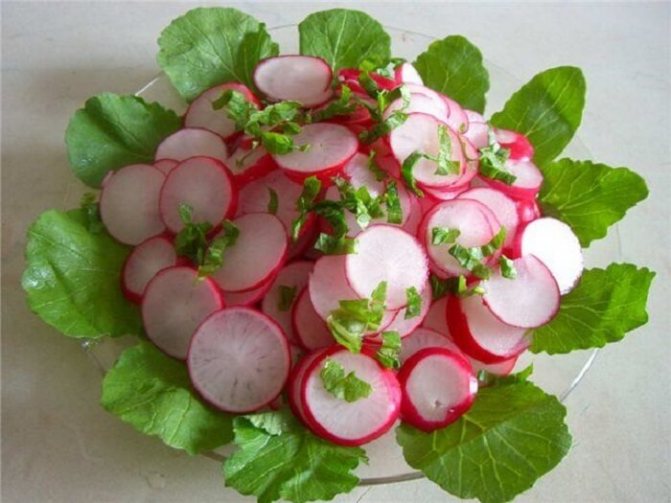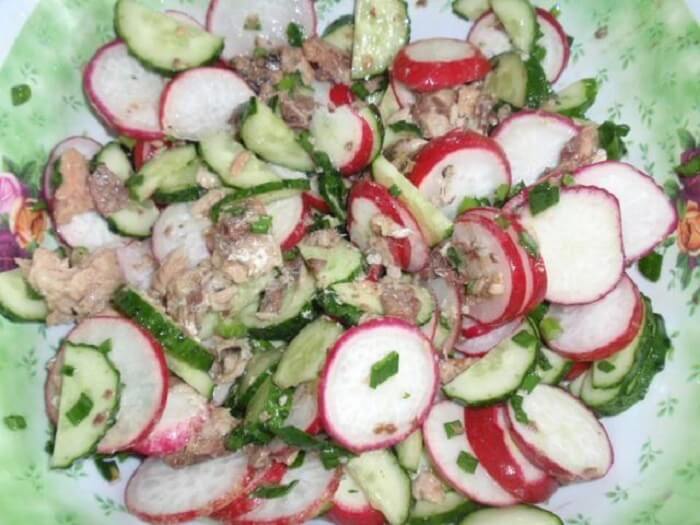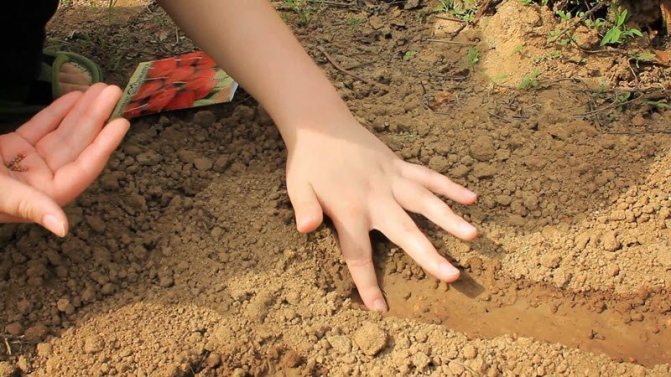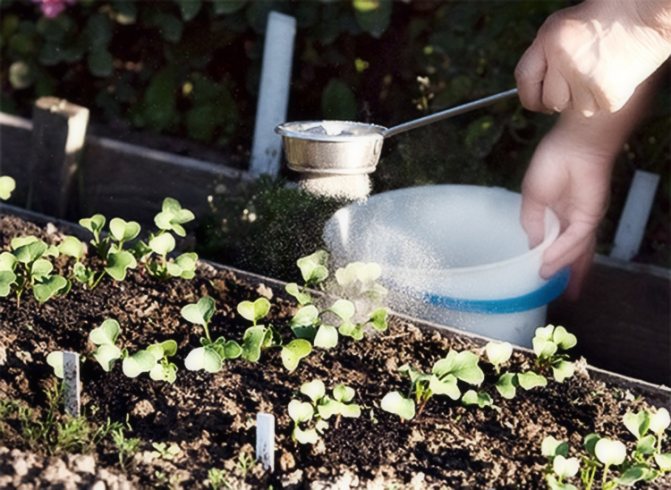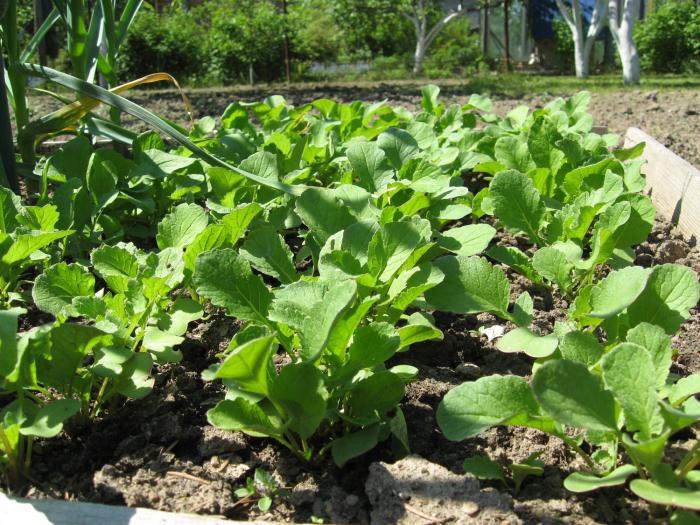ABOUT planting radishes in open ground in spring today we'll talk in our article, about rules of cultivation and care , because radish is a favorite culture of gardeners, and for good reason. Possessing excellent taste, it is extremely unpretentious in cultivation - it grows best at +18 degrees and is not afraid of frosts up to -2 degrees C. In this article we will consider various ways and methods of growing radishes in the open field, with which it is easy to get a high yield ...
Planting and caring for radishes
- Landing: sowing seeds in the ground - before winter or in spring, from late March to mid-April.
- Lighting: bright sunlight.
- The soil: loose, light soil of neutral or slightly alkaline reaction (5.5-7.0 pH).
- Predecessors: unwanted - any cruciferous crops. The good ones are potatoes, cucumbers, legumes. After the radish, it is best to grow tomatoes on the site.
- Watering: frequent and plentiful: in the usual spring with rains and thunderstorms - once a day, in the morning or after 17.00, but in abnormally hot and dry weather - both in the morning and in the evening. The soil on the site should be slightly moist at all times.
- Top dressing: when grown on scanty soils, fertilizing is applied twice, on rich ones - one. Complex mineral fertilizers are used.
- Reproduction: seed.
- Pests: cruciferous fleas and bears.
- Diseases: bacteriosis, keela, black leg.
Read more about growing radishes below.
What crops can be planted next to radishes in the garden
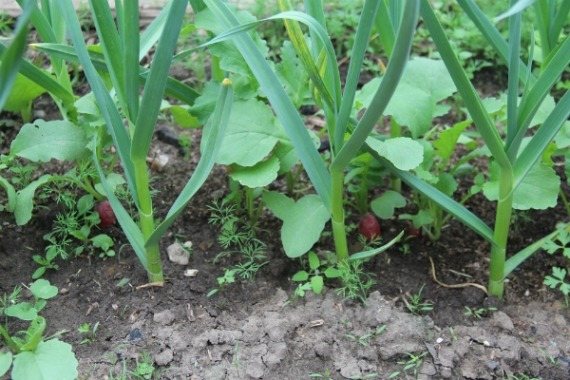
It is not necessary to fill the beds with the same crop. Combined planting allows you to get more vegetables in one area. In addition, plants can have beneficial effects on each other. For example, bush beans planted next to a radish will improve its taste and scare away the cruciferous flea.
Crops such as lettuce and head lettuce can also act as pest defenders.
- Greens are suitable as neighbors for radishes: spinach, dill, parsley. You can plant onions, garlic, cabbage, carrots nearby.
- Will grow well in the immediate vicinity: cucumbers, tomatoes, strawberries, corn, peas.
Vegetable radish - description
The radish plant is grown in many countries. It is a root vegetable with a diameter of 2.5 cm, covered with a thin skin of red, pink or white-pink color with a sharp taste due to the mustard oil contained in its pulp. The radish vegetable is a long day plant, for normal development it needs 13 hours of daylight. But its growing season is short, so you can grow a radish root crop throughout the season, planting it literally every week.
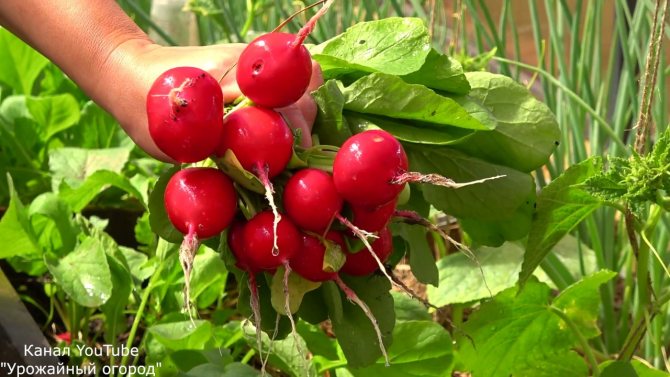

Special devices
Many gardeners involved in the cultivation of radishes are interested in whether it is possible to sow a root crop so that it does not have to be thinned out in the future, and how to do it? For the convenience of planting and to avoid subsequent thinning, you can use radish seeders. They are homemade and special agrotechnical. The latter are sold in garden stores. Seeders allow you to save time for sowing, save seeds and not do the subsequent thinning of the seedlings. The seeder itself is a kind of seed dispenser that dispenses seed evenly over a period of time.
Read more about choosing different types of devices for planting radishes and making a seeder with your own hands here.
Planting radishes in open ground
When to plant radishes in the ground
Radish seeds germinate at a temperature of 1-2 ºC, for normal development, the plant needs a temperature of 15-18 ºC, but no more, since too warm air with a lack of lighting (and at this time of the year the day is still short) only leads to the growth of tops, in while the root crop does not grow and coarsens. As soon as the soil thaws and warms up, the radish is planted in the ground. This usually occurs in mid-April, although in warm areas, early varieties of radishes are sown at the end of March.
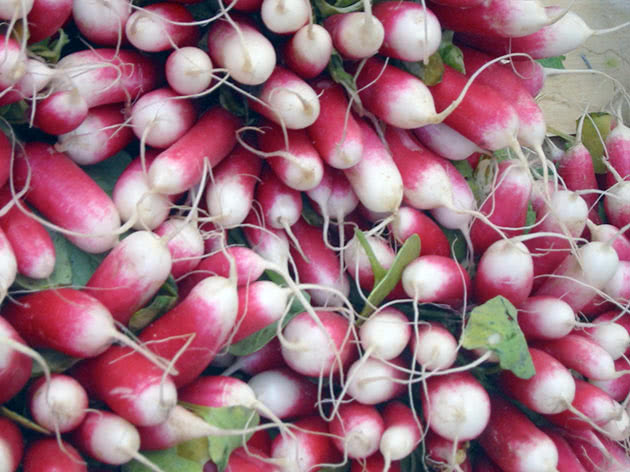

Soil for radishes
Growing radishes from seeds begins with soil preparation. The area where you plant radishes should be sunny at least the first half of the day and closed from the wind. The optimal soil for radishes is a loose, light soil of a neutral or slightly acidic reaction, the pH of which is in the range of 5.5-7.0 units. Too acidic soils must be limed before planting radishes.
- Roses: preparation and shelter for the winter, autumn pruning
It is good to sow radishes in the area intended for the future for growing tomatoes: you can sow radishes on it every week until May 20, collect a good harvest of root crops and at the same time prepare the soil on the site for growing tomatoes. Heavy and cold soils or poor sandy loam, if you want to grow radishes in them, you will have to dig up with humus at the rate of 2-3 kg per m². The soil for radishes is not fertilized with fresh manure.
You can plant radishes in the area where potatoes, cucumbers, tomatoes, beans were previously grown, but in the area where turnips, radishes, turnips, daikon, watercress, cabbage and horseradish grew you will not grow a good harvest of radishes. It is advisable to change the place for radishes every year, so that each time it has predecessors from a different family.
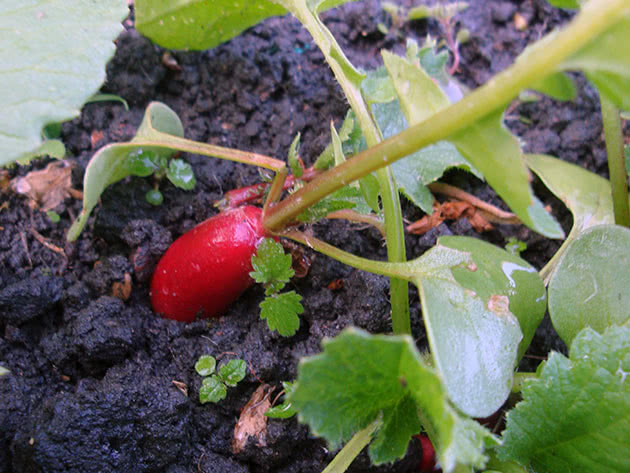

For spring sowing, the site is prepared in the fall: they dig up the soil to the depth of a shovel bayonet with compost or humus - then in the spring, just before sowing, the digging depth with the simultaneous application of phosphorus-potassium fertilizers can be no more than 20 cm.
How to plant radishes in open ground
Radish seeds are sown densely into grooves previously shed with water to a depth of 2 cm, observing the distance between the rows of 15-20 cm.The grooves are covered with loose soil, then the surface is compacted, but not watered, but the area is covered with a layer of peat or humus 2 cm thick. after five o'clock in the evening and until the morning, the bed is covered with a film before the seeds germinate. The germination time depends on the weather. In good, dry and sunny weather, seeds can germinate as early as 3-4 days.
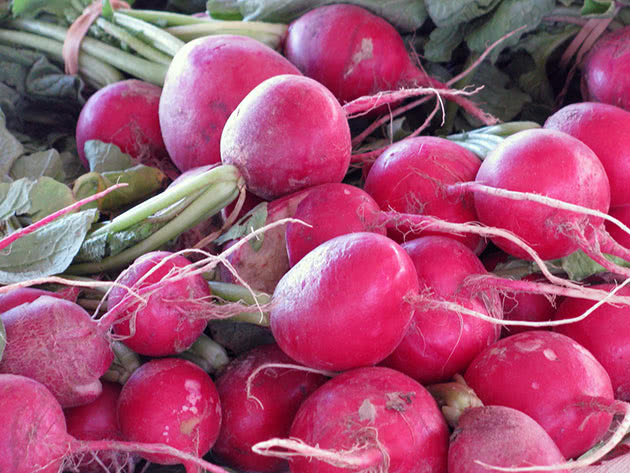

At the development phase of the seedlings of the first leaf, they are thinned out, leaving a distance of 3-5 cm between the specimens.If you are a patient person, sow the seeds immediately at the specified distance so that you do not have to break through the seedlings later, because this procedure can damage the roots of the main seedlings, and they will develop worse, and as a result, their shooting may occur. With proper care, growing radishes outdoors until harvest takes 20-30 days.
Planting radishes before winter
We told you about the timing of spring sowing, and the planting of two-year-old winter radish is carried out at the end of autumn. Planting radishes in the fall is carried out after the start of frost - in mid or late November. Not all varieties of radish are suitable for winter sowing, but varieties such as Yubileiny, Spartak, Mercado, Mayak, Carmen are able to germinate even at low temperatures.
The preparation of the site for sowing is carried out at the end of summer: the soil is dug up and fertilized, adding half a bucket of humus or rotted compost to 1 m², 1 tablespoon of double superphosphate and potassium sulfate.After fertilization, the bed is covered with a film, pressing its edges with stones or bricks so that the shelter is not blown away by the wind.
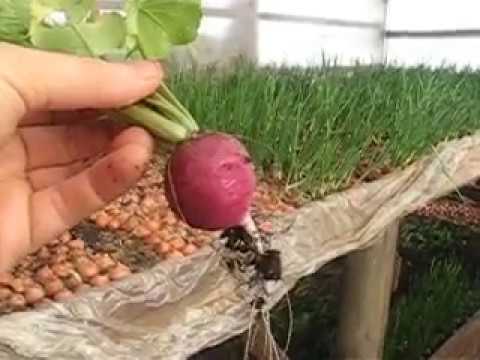

The autumn sowing procedure differs from the spring procedure in that in the fall the seeds are thrown into dry ground, and after the seeds are covered, the garden bed is mulched with dry soil or peat, the surface is compacted and the area is covered with snow if it has already fallen out.
What is the advantage of winter sowing? The fact that the harvest of the radish sown in the fall, you will receive next year two weeks earlier than the harvest of the radish sown next spring.
Answers to frequently asked questions
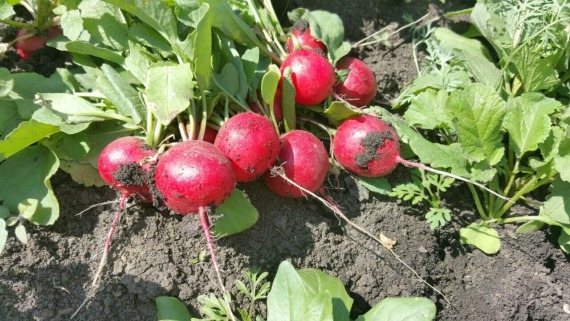

It is not always clear to beginners which mistakes in growing radishes lead to certain problems. But the answers to such questions are known to specialists, who willingly share information with everyone.
What to do so that the radish does not taste bitter
There are several reasons why the root crop grows bitter. This can happen if the radish does not have enough moisture or oxygen as a result of overgrowing the ridges with weeds, too dense plantings. Fruits also acquire a bitter taste as a result of over-ripening. That is why radishes need to be watered, thinned, weeded and loosened in a timely manner. Harvesting is necessary in a timely manner.
On a note! You can remove the bitterness from radishes by soaking the roots for half an hour in salted water.
So as not to go to the arrow


Hot weather is the most common reason for radish shooting, which is why it is best to grow the crop in spring and late summer. The optimum temperature for growing root crops is 18-20 ° C.
Improper watering, both too rare and abundant, can also lead to the appearance of an arrow. Water the garden so that the soil is always slightly damp.
Lack of moisture is especially dangerous when the first pair of true leaves appears. The third reason is too much light. Radish belongs to crops that need short daylight hours. If growing during the summer months, cover the bed with opaque material from 6pm to 6am.
How to prevent radish cracking
In the early stages of growing radishes, uneven watering and too dense plantings lead to cracking. With dense sowing, the plants begin to experience a lack of light, which leads to the fact that the roots burst. The same happens if the plant is deficient in moisture and suddenly receives it in large quantities at once.
You can not overexpose ripe radishes in the garden, this will also lead to cracking. An additional prevention of an undesirable phenomenon will be the use of selected fresh seeds and adherence to the rules of crop rotation.
How many times can you plant radishes per season
To get a good harvest of radish, it is planted up to 4 times per season, with a break for hot summer periods. The first sowing is carried out in April, the second time the culture is planted with seedlings at the beginning of June, the third planting is carried out again by the seedling method at the border of July and August, 4 sowing is carried out in the last days of summer. In order to get a harvest of radishes in the fall, heated greenhouses are used in the northern regions, and in the middle lane the culture ripens right on the ridge.
Radish care
How to grow radishes
Outdoor care for radishes consists of watering, weeding and loosening the row spacings. If you put a layer of mulch on the garden bed after sowing, maintenance will not be tedious, but try to complete all maintenance procedures on time.
Watering the radish
Radish is a moisture-loving culture, the optimal soil moisture for the normal development of its root crops should be about 80%, so you will have to water the site often, especially at first, otherwise the radish will be bitter. With insufficient watering, the plant shoots and roots do not develop. If watering is too frequent or heavy, the roots will crack.
How to water a radish to achieve a good and high-quality harvest? If the spring is normal, with rains and thunderstorms, watering of radishes is carried out every day in the morning or after 17.00, but if the spring turns out to be dry, then the soil on the site will have to be moistened daily both in the morning and in the evening. It is especially necessary to strictly monitor the condition of the soil after the appearance of the first true leaf at the seedlings. Only on condition that the soil in the radish beds is always in a slightly damp state, you can grow juicy, tasty root crops.
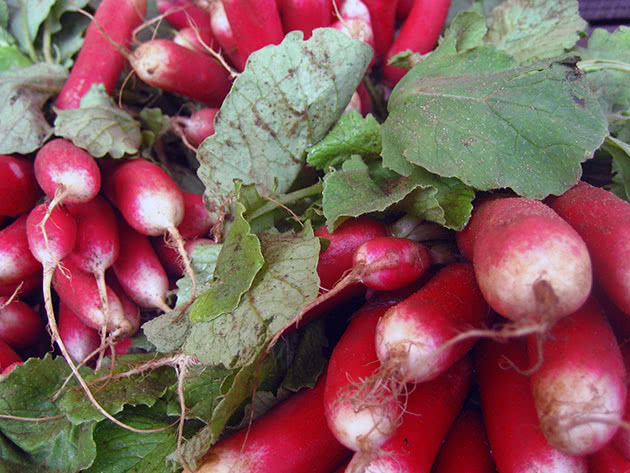

Fertilizing radish
On poor soils, you need to feed radishes twice during the growing season, for radishes growing on rich soils, one feeding is enough. Try not to overdo it with the nitrogen component, because in this case all the vitality of the radish will be spent on growing tops, and the roots will be elongated and oversaturated with nitrates.
- How to deal with bean pests
How to fertilize radishes, what fertilizers can be applied to the soil without the risk of nourishing root crops with substances hazardous to human health? Here is a recipe for a balanced mixture of fertilizers that will help radishes form a healthy and juicy root crop: compost and humus, in the amount necessary for your soil, 10 g of potassium fertilizer and superphosphate, 10-15 g of nitrate, one and a half liters of ash. It is enough to apply only mineral fertilizers to the fertile soil.
Site selection and preparation
Site preparation begins in advance. On clay soil, radishes do not grow due to the rapid formation of a soil crust. To do this, supply the earth with top dressing: humus, peat and coarse sand. If possible, it is better to choose a different type of soil. Then you can get by with compost or humus. If the soil is fertile, then you do not need to fertilize it.


Pay attention to the location of the garden. The site must be protected from wind and sun. The best location is southern and southeastern lands. If the location is unsuccessful, you can try to dive a radish.
Pests and diseases of radish
The main enemies of the radish are the cruciferous flea and the bear, the rest of the garden pests (aphids, wireworms, caterpillars) do not have time to greatly harm the radish due to its rapid growth. The cruciferous flea is dangerous for radish precisely at an early stage of its development, since it is capable of destroying barely hatched defenseless seedlings in the entire area in a few days. When the seedlings get stronger, the flea is no longer afraid of them.
How to process radishes so that the cruciferous flea does not annoy him? To scare off the insect from young green leaves, the tops are sprayed with a solution of wood ash: 2 glasses of fresh ash and 50 g of grated laundry soap are dissolved in 10 liters of water. You can just scatter the ash over the area. It must be said that both of these methods are ineffective, and the most reliable protection against fleas is the construction of a shelter: metal arcuate supports are installed along the length of the entire bed, on which spunbond is thrown. Under this shelter, the radish breathes normally, the tops do not burn under the scorching rays of the sun, and most importantly, the harmful insect cruciferous flea, which destroys the crops of radish, does not penetrate under the spunbond. After the tops have grown, the shelter can be removed.
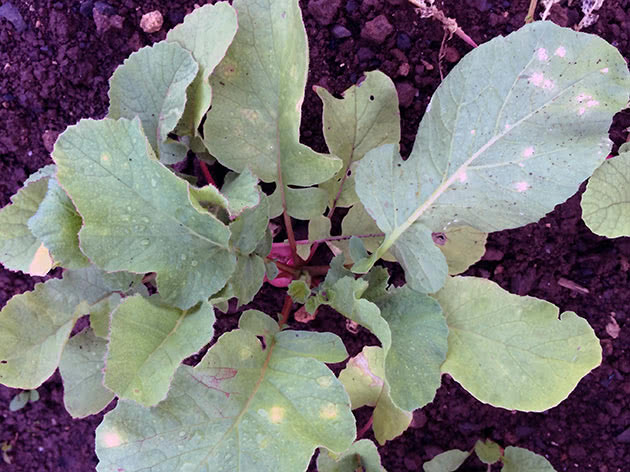

Medvedka often harms early varieties of radish in the greenhouse, where it creeps up to warm in the spring. If you grow radishes in the open field, then this terrible enemy is unlikely to have time to do much damage to your crop. And it's very hard to fight the bear.
What is the problem with radishes? Of the diseases, bacteriosis is dangerous for radish, manifested by premature yellowing of leaves, mucus and decay of root crops, keel, which is also determined primarily by yellow leaves, as well as by outgrowths and swellings on root crops, and a black leg, which affects plants even in the seedling stage, which is why their leaves turn yellow and curl and the stems turn black at the base.
To avoid these problems, choose varieties that are resistant to diseases for growing, and observe the conditions of agricultural technology, and most importantly, remove diseased plants from the site in time. Keel can be fought by treating the soil around the plants with milk of lime (2 cups of fluffy lime per 10 liters of water), the consumption is 1 liter of milk per plant.Instances affected by the black leg are treated 2-3 times with an interval of a week with infusion of onion peel (pour 20 g of peel with a liter of water and leave for 24 hours).
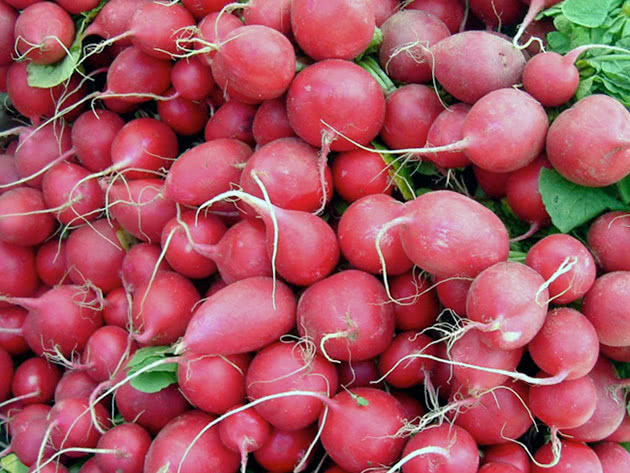

Radish processing
Readers often ask questions about how to treat radishes from pests or how to treat radishes from diseases. It is undesirable to use pesticides in the fight against diseases and pests of rapidly ripening root crops if you are concerned about your health and the health of those who will eat this radish, therefore the best protection is compliance with all the rules of cultivation and care.
If the recommendations described by us did not give a result, and it is necessary to take urgent radical measures, then you will have to process the radish from the black leg with a solution of copper sulfate (1 tablespoon of the drug, 50 g of shavings of laundry soap per 10 liters of water), and treat bacteriosis by treating plants with a 1% solution bordeaux liquid.
But we repeat: everything that you process the radish with, you will then eat.
Protection of seedlings from pests
The main pest that prevents radish from fully developing is the cruciferous flea, which eats the first succulent leaves of the plant, thereby stopping its growth and development. There are several ways to protect yourself from this pest:
- Shelter with agrofibre. Immediately after the appearance of the first shoots, the entire garden bed is covered with thin agrofibre, which easily allows light and moisture to pass through, but prevents insects from entering.
- Tansy powder. The flowers of tansy or celandine prepared in advance are ground into powder and showered with such a powder on the shoots of radish. The strong smell prevents the flea from eating the first green leaves, with which the tuber is formed.
- Sticky flags. A sticky mixture is applied to a flag made of dense material, with which it is necessary to "mark" the first shoots of radish. Thus, the flea gets onto the sticky surface without damaging the seedlings.
Watch the video! Radish care and cultivation in a greenhouse
Harvesting and storage of radishes
The radish does not ripen at the same time, therefore, when asked when to dig up the radish, we answer: you need to remove it selectively, as it ripens. Harvesting radish is best done in the morning, overnight watering the garden plentifully. Having pulled out the roots, shake off the rest of the soil from them, cut the tops not under the very root crop, but at a distance of 2-3 cm from it, and do not cut off the roots at all. How much and how to store radishes?
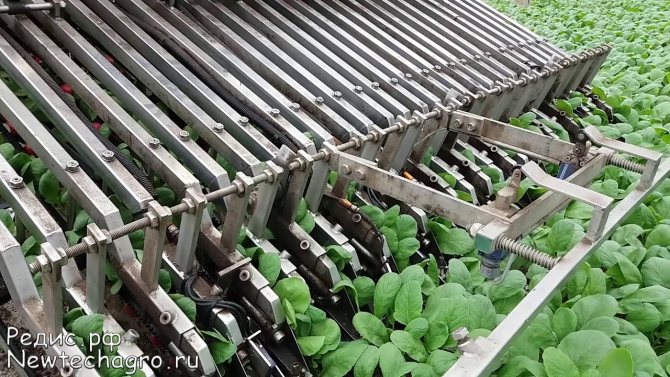

From long-term storage, even in the best conditions, radishes become bitter and flabby, so abandon plans to harvest this root vegetable, such as carrots or beets, especially since fresh juicy radishes can be grown at any time - not in the garden, so in greenhouse. The radish harvest removed by the described method is stored in plastic bags in the vegetable compartment of the refrigerator for about a week.
Possible problems and difficulties
The main problem when planting radish can be the thickening of crops., the distance between plants should be at least 2 cm. Radish also reacts poorly on long daylight hours. The fact is that radish will not yield root crops with a day length of more than twelve hours. Therefore, you need to plant radishes either in early spring or before winter. Soils for vegetables are suitable for sandy loam or loamy.
Of the fertilizers, vermicompost, compost for organic farming or mineral fertilizers will be relevant. The pest of radish is the cruciferous flea. Therefore, immediately after planting, it is necessary: sprinkle the beds with ash, cover with moisture and air permeable material and do not remove it until the leaves of the plant coarsen and become unattractive to insects.
Types and varieties of radish
Radish varieties for open ground are divided according to ripening periods into ultra-early, early-maturing, mid-maturing and late-maturing.
Ultra-early, or early ripening varieties of radish
ripen in 18-20 days. The most famous of them:
- 18 days - the roots of this variety reach maturity during this period, they have juicy, tender pulp, cylindrical shape, deep pink color;
- Firstborn - an ultra-early high-yielding hybrid that ripens in 16-18 days. Large, rounded dark red roots of this variety are resistant to shooting and cracking, their flesh is sweet and juicy.
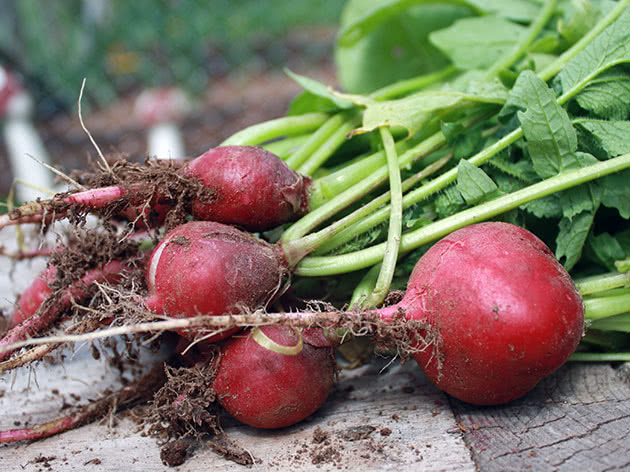

Early maturing radish varieties
ripen in 20-30 days from the moment of germination, the best of which are:
- Jerusalem artichoke: planting and growing, care
- Ilka - the yield of this variety is quite high, the roots are scarlet, rounded, weighing from 15 to 25 g, dense, juicy, the flesh is white and white-pink, the taste is medium-sharp, without bitterness. The variety is resistant to temperature drop, shooting, porosity or woody pulp;
- French Breakfast - also a popular fruitful variety with long cylindrical dark red fruits, resistant to shooting, weighing up to 45 g with a rounded white tip. The pulp is juicy, without bitterness. Disadvantage: in extreme heat, it shoots;
- Sachs - this variety ripens in 23-27 days, the shape of the root crop is round, the color is bright red, the flesh is white, juicy, with a slightly pungent taste. The average weight of a root crop is 22 g. The variety is resistant to flowering, retains freshness for a long time;
- White Fang - conical roots of this variety, original for white radish, ripen in 33-40 days, reaching a length of 12 cm and gaining weight up to 60 g. The pulp is juicy, the taste is slightly sharp;
- Heat Is a high-yielding variety that ripens in three weeks. Root crops are small, dark red, round, weighing up to 25 g. The flesh is white or white-pink, the taste is mild. The variety, despite the name, does not like heat, so when grown in hot weather, it should be covered with a canopy.
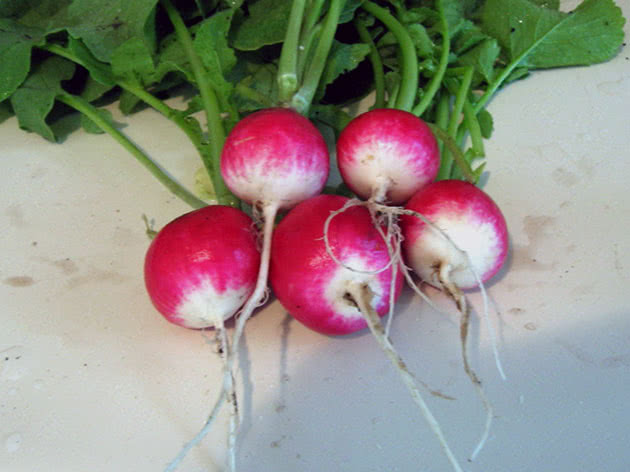

Mid-season radish
ripens in 30-35 days. The best varieties in this group are:
- Vera - Stalk-resistant high-yield variety with bright red roots of almost the same size, resistant to cracking;
- Helios - a variety with yellow round roots with a juicy pulp of a pleasant taste;
- Quantum - a fruitful variety that ripens in 30 days with pinkish-raspberry roots of a delicate taste. Keeps elasticity for a long time during storage;
- Zlata - ripens in a maximum of 35 days from the moment of emergence. A yellow round root vegetable with dense, tender and juicy pulp reaches 18 g in weight;
- Duro - one of the most popular and fruitful varieties with very large (up to 10 cm in diameter), round red roots weighing up to 40 g, which requires a more spacious planting in rows: the distance between specimens should be at least 10 cm.The variety is resistant to stalking, lingering and cracking of fruits, well stored.
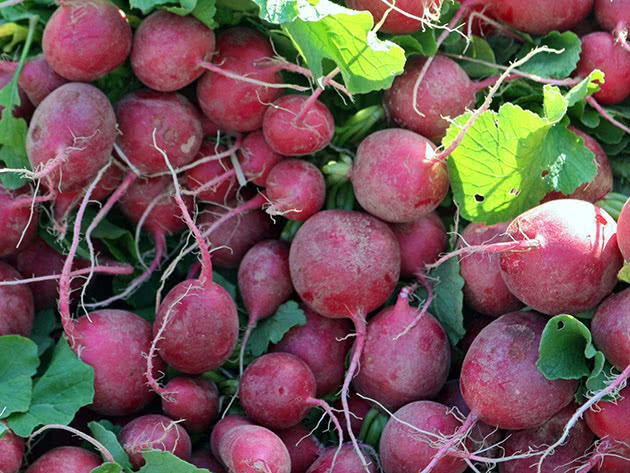

Hilling, thinning, loosening and weeding
Hilling is useful for radishes in that it gives the plant resistance, provokes root growth. It is carried out simply: sprinkle moist soil to the stem of the plant until a shaft is formed. At the same time, it has been proven that hilling helps to increase yields by 10-14%. However, the procedure is carried out carefully so as not to damage the plant. More often this agrotechnical method is used for nightshades and cabbage. The best time to do this is before watering or after rain.
Thinning helps to get rid of mechanical damage and disease infection. This is the target distance that is maintained to ensure safe growth. In radishes, depending on the variety, when planting, a distance of 5 to 10 cm is noted. At the same time, they simultaneously get rid of weeds and remove yellow leaves to eliminate the possibility of infection.
Loosening helps to replenish the supply of useful trace elements and deliver oxygen to the roots of the radish, which provokes their growth. Loosening destroys the soil crust, and during the heat, loosening helps to avoid cracks in the ground.
Weeding involves removing weeds that take away water and nutrients from the plant.At the same time, it is correct to do this at the stage of radish emergence. Before each sowing, the soil should be cleared of weeds as much as possible.
What temperature can the seedlings withstand, are they afraid of frost?
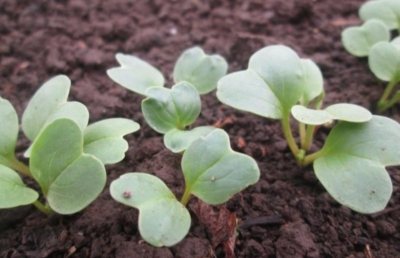

Radish is a frost-resistant culture, which is most important for the regions of the Urals and Siberia. Seedlings appear at a minimum temperature of +5 degrees, are able to survive frosts on soil up to minus five.
With a decrease to minus eight, damage to the leaves is possible, if the frost lasts for a long time, the root crop may suffer. It should be borne in mind that a low temperature slows down the development of a vegetable.
More information about the temperature at which the radish grows, whether it can withstand freezing, is described in another article.
Features of autumn planting
To get a bountiful harvest when planting radishes in October, they are planted in the summer - in June, July, and better - in the third decade of August. Often winter weather conditions make it difficult to grow a full early spring harvest. But at the end of summer and at the very beginning of September, it is easier to deal with pests, and the weather behaves predictably. Moreover, the autumn harvest will bear fruit 2 weeks earlier than the spring one.
After the seeds have been spread along the grooves during planting, fertilizer is added. Humus or compost is more often chosen. However, it is not advisable to use fresh manure for this purpose: radish does not tolerate it. In this case, it is better to make furrows in advance - before the soil freezes, but the seeds are sown on the contrary after.
To prevent the appearance of snow, it is better to cover the groove on top with a film when planting.
How is it different from growing at other times of the year?
Radish is a cold-resistant plant. To grow a tuber, she needs 10 - 12 hours of daylight hours, so planting is best done in early spring.
When the day becomes longer, and the air temperature warms up to +24 - 25 degrees, this negatively affects the development of tubers - the radish begins to bloom and throw out the arrows, entering the breeding phase.
If it is necessary to re-plant in the summer, take into account the preferences of the radish for soil and temperature, choosing more suitable varieties with a late ripening period.
Planting in egg cells
You can plant radishes in egg cells. This method has been used for a very long time, and many in various forums claim that it is quite effective. Thanks to this method of planting, the radish takes on a neat round shape. In addition, thinning of the culture is not required, since the distance between the cells is considered sufficient for normal growth.
To plant radishes in egg cells, you must:
- prepare the bed in advance. For this, the soil is dug up and loosened, after which it is leveled;
- cut off the bottom of the cells, lay the resulting shapes on the ground. It is necessary to spread it so that the holes are practically in the ground;
- fill each hole with soil, put one radish seed;
- cover crops with a layer of earth, water thoroughly.
There are many videos and photos that allow you to study in detail the process of planting radishes using this method. Anyone can find them on the Internet.
The sprouts sprout in the same way as with the usual planting of radishes in the ground. However, this technology makes it possible to preserve the required distance between future plants in advance.
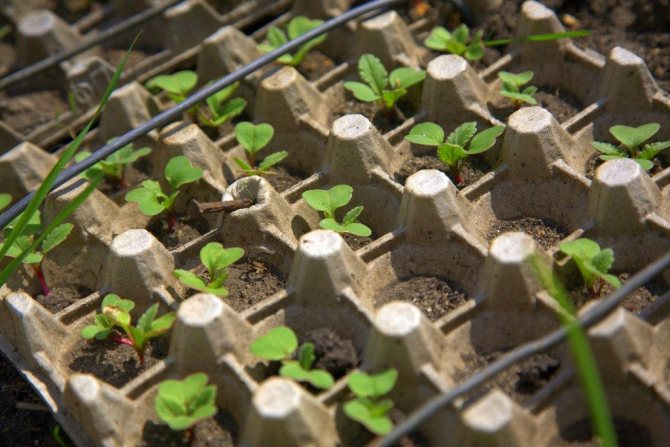

This is interesting: egg cells are an excellent substitute for trellis: this option is more economical and does not require much effort for the same installation.
When to sow
Radishes are planted as seeds in a greenhouse or directly in the garden beds. Landing time depends on climate, moon phase and location.
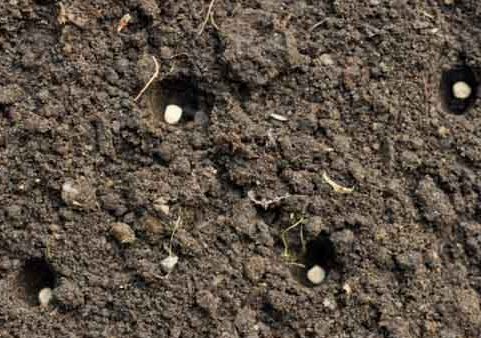

Since the plant is frost-resistant, it can be sown after the descent in the area of snow. To seedlings appear faster, the beds are covered. During the day, the material is removed, and in cloudy weather it is raised for airing.
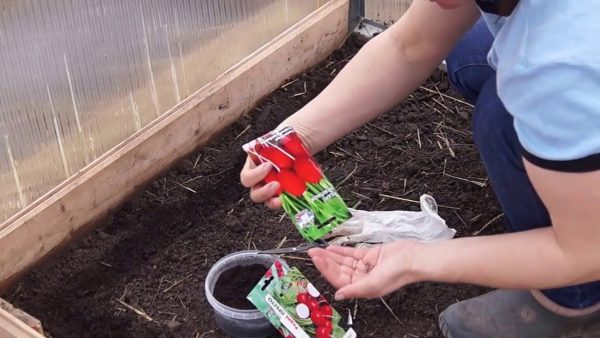

You can sow radishes in the greenhouse between March and April. Sometimes it is sown in February.Since there is not enough light in such conditions, the seeds are germinated before planting.
Preparing radish seeds for planting
Selection of quality seeds and disinfection
High-quality seeds are needed to ensure a large harvest. We select a germinating seed in any of the following ways:
- Soaking in fresh water... Pour the seeds in a bowl with water at room temperature. After half an hour, we look at the result: good achenes will settle to the bottom, empty ones will remain at the top. We remove them, dry the rest.
- Soak in salt water... Dissolve 50 g of table salt in a liter of water and lower the seed material there for a couple of minutes, stirring them regularly. Drain the pacifiers remaining on the surface, wash and dry the good seed.
Before planting, you can soak them in a solution of potassium permanganate (1 g per liter) for 15 minutes to rid future plants of possible diseases, then rinse.
Acceleration of radish germination
Some gardeners also soak the seed in growth stimulants such as "Epina" (3 drops per 1 liter of water) or "Zircon" (0.025 ml per 0.5 st. Water) for three hours, dry and sow. This will make the radish rise even faster.
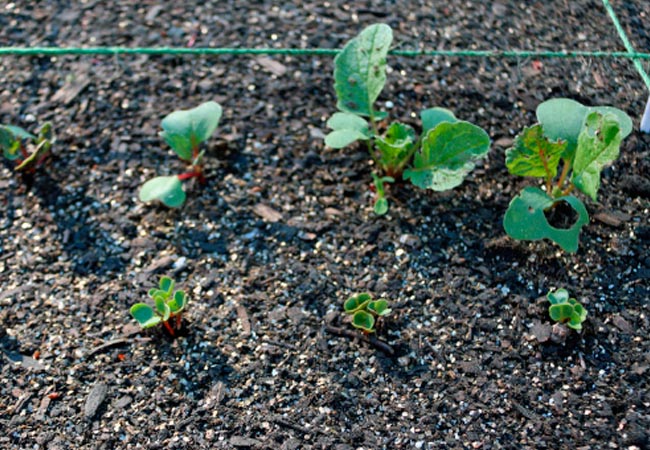

How to plant radishes with seeds, seedlings
Hardening radish seeds
You can harden the achenes if early spring sowing is to be done - in March or early April, then they will not be afraid of temperature changes. We carry out hardening of radish according to the instructions:
- We wrap the seeds in cheesecloth moistened with water at room temperature and leave for 24 hours.
- We keep in the refrigerator for 4 hours.
- We leave again in the room for a day.
- Put in the refrigerator for 4 hours.
- We repeat the hardening procedures until the seeds are pecked.
We immediately plant the germinated seed material in the prepared beds, since the growth processes are already activated.
How to get a good harvest of radishes
To obtain a good harvest, radishes are provided with comprehensive care. This includes:
- timely watering;
- applying dressings;
- loosening;
- weeding and thinning;
- pest control.
Timely procedures will be the key to a high harvest.
